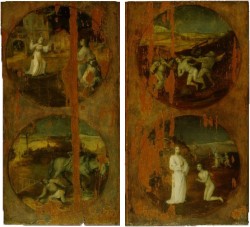
Wittrock 1979
“Die sogenannte Sintflutflügel des Hieronymus Bosch. Ein Versuch zur Interpretation der drei ersten Medaillons der Aussenflügel” (Irma Wittrock) 1979
[in: Oud Holland, vol. 93 (1979), n° 1, pp. 52-60]
[Also mentioned in Gibson 1983: 128 (E324)]
Wittrock believes she has found the source of the top-left tondo on the so-called Flood wings (Rotterdam, Museum Boijmans Van Beuningen) in Augustine’s De Civitate Dei, namely the story about Hesperius: a deacon saves a farm which is being attacked by demons. The tondo at the bottom-left and the one at the top-right can be traced back to a sermon by the Dominican Peregrinus (about a man who refuses to go to church on a Sunday and is carried away to hell by the devil). More than probably Bosch was not directly inspired by these authors but he knew other versions of these exempla. A text which could explain the fourth tondo (bottom-right) has not yet been found.
Wittrock concludes that it is certain that in the tondos Bosch faithfully depicted exempla. He did not find his subject matter in the subconscious or in fantastic visions. But the depiction of the exempla was adapted and distorted by his powerful imagination.
A weak aspect of Wittrock’s hypothesis is that according to her there is a connection between two of the tondos, but not between these two and the other two, except a very superficial one (the victory of Evil / the victory of Good) …
[explicit]